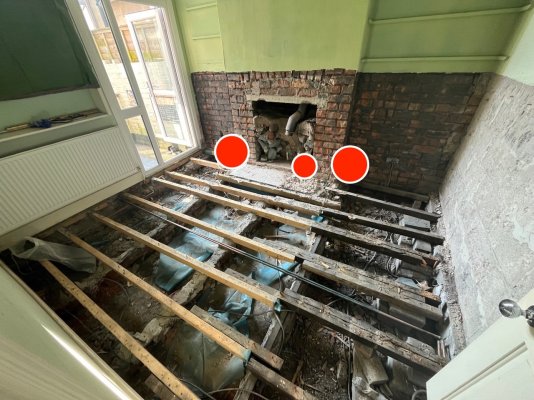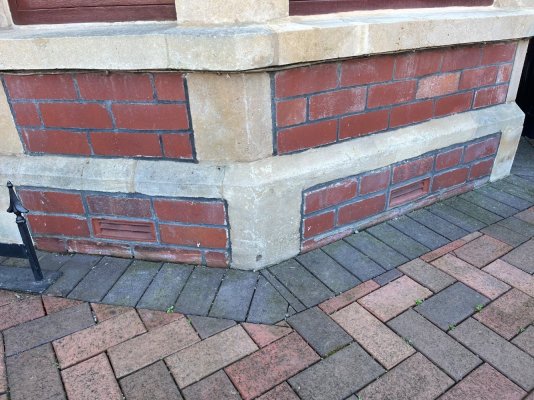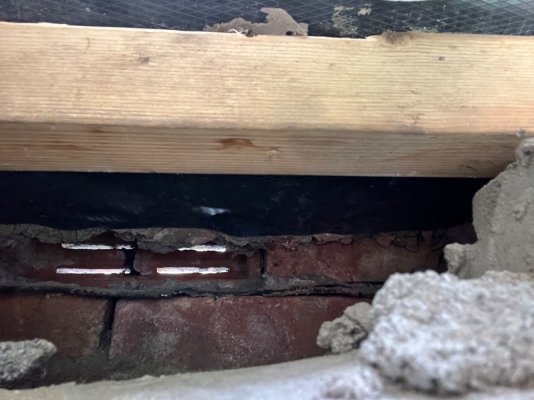Good morning,
This is my first post on this forum, I’m seeking advice as there seem to be some very knowledgeable folk on here. Unfortunately, my house has a dry rot infestation which has caused no end of stress and bother.
Background:
1905 build Edwardian terraced house, two stories, purchased 1996. When we moved in the two ground floor reception rooms had been knocked through into one, flooring was thick fitted carpet on underlay sitting on floorboards on a suspended joist floor, the joists are 3”x2”.
We have spent the intervening 28 years opening fireplaces and restoring the house to its original configuration. This included rebuilding the dividing wall between reception rooms 1 (front) and middle (2). The work was carried out in 2006, and I used a builder who had come highly recommended (of more anon, sadly): as the floorboards were in poor condition, I decided to have a laminate floor installed in both rooms over the boards. The laminate is 10mm thick with 3mm oak veneer on top. In retrospect, I know that I should have opted for replacement floorboards alone …. hindsight, and all that.
All was well until January of this year (18 years having elapsed) when I was horrified to discover fruiting bodies of dry rot emerging around the hearth in room (2). I immediately took advice from another builder friend who referred me on to a Property Care Association registered company, in the hope that they could provide an insurance-backed guarantee for subsequent works.
A survey has been conducted which confirms extensive dry rot in the wooden subfloor which extends out into the middle of the room. The surveyor thinks this has been present for 18 months to two years. Thankfully it has not entered room 1. The dry rot is present in the party wall and the neighbour (since 2021) admits that he has rotten floorboards in the hearth area directly opposite our outbreak. The surveyor and I were invited in, and one floorboard has fallen through completely, with cuboid cracking on the underside. The surveyor popped his camera into the void and confirms the presence of what appears to be dead dry rot remains on the joists.
To cap it all, the one and only underfloor vent to outside in our room is blocked, seemingly by the builder who carried out the work in 2006. So, the theory (and that's all it is, cannot be confirmed) is that the dry rot started in next door, when the neighbour improved ventilation in his room (due to a ‘musty smell’) the mycelium migrated through the party wall and found a more agreeable place to live in my house.
The exposure schedule has commenced, and it seems that I now have two options:
1. Replace the original woodwork with a new suspended timber floor after the eradication process has been completed.
2. Opt for a concrete floor option, which will entail removal of the wooden floor in room 1 due to the ventilation issues this will cause if only room 2 is so-treated.
The complication is that the neighbour has seen how drastic and destructive the eradication work is on my side and won’t (yet) entertain similar works on his side (I suspect that all this will change once the dry rot manifests itself on his side). For this reason, my contractor will not issue a guarantee for his work, as there’s every chance that the dry rot may reappear elsewhere in my property if left unchecked in the neighbours - I can see his point, in fairness.
So, the key question: I wonder which flooring option I should go for?
Budget is not an issue, I am more concerned that the eradication is completed successfully in room 2, rather than how much it costs.
The other factor is that I intend to sell-up and move on in the spring of 2027 when I retire! My final "forever home" will be a detached house, after this palaver
Apologies for the somewhat wordy summary, I’d be grateful for advice on my options from those more qualified to speak than I.
Some photos:
Dry rot just before exposure woks commenced last week:

The room before exposure: the single under floor vent (blocked) is directly under the patio door:
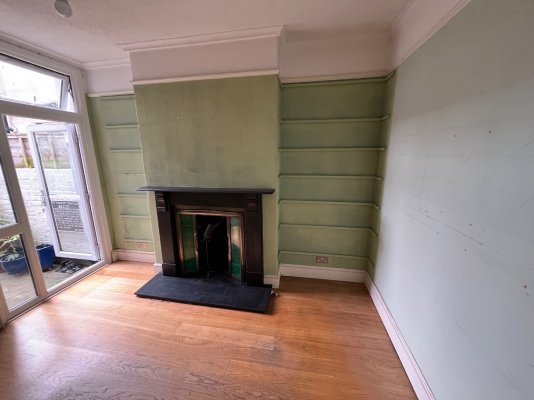
Exposure works ongoing. The fireplace was safely and skillfully removed by my contractors without damage. The blue DPC plastic has caused a lot of issues, with mycelium spreading beneath it. I would take issue with my original builder about this (apparently) shoddy work, but he died in 2014 ....
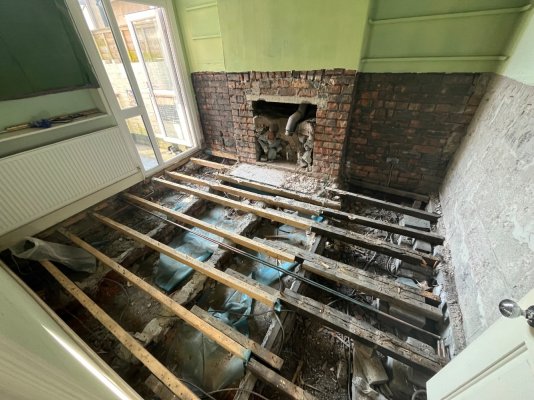
This is my first post on this forum, I’m seeking advice as there seem to be some very knowledgeable folk on here. Unfortunately, my house has a dry rot infestation which has caused no end of stress and bother.
Background:
1905 build Edwardian terraced house, two stories, purchased 1996. When we moved in the two ground floor reception rooms had been knocked through into one, flooring was thick fitted carpet on underlay sitting on floorboards on a suspended joist floor, the joists are 3”x2”.
We have spent the intervening 28 years opening fireplaces and restoring the house to its original configuration. This included rebuilding the dividing wall between reception rooms 1 (front) and middle (2). The work was carried out in 2006, and I used a builder who had come highly recommended (of more anon, sadly): as the floorboards were in poor condition, I decided to have a laminate floor installed in both rooms over the boards. The laminate is 10mm thick with 3mm oak veneer on top. In retrospect, I know that I should have opted for replacement floorboards alone …. hindsight, and all that.
All was well until January of this year (18 years having elapsed) when I was horrified to discover fruiting bodies of dry rot emerging around the hearth in room (2). I immediately took advice from another builder friend who referred me on to a Property Care Association registered company, in the hope that they could provide an insurance-backed guarantee for subsequent works.
A survey has been conducted which confirms extensive dry rot in the wooden subfloor which extends out into the middle of the room. The surveyor thinks this has been present for 18 months to two years. Thankfully it has not entered room 1. The dry rot is present in the party wall and the neighbour (since 2021) admits that he has rotten floorboards in the hearth area directly opposite our outbreak. The surveyor and I were invited in, and one floorboard has fallen through completely, with cuboid cracking on the underside. The surveyor popped his camera into the void and confirms the presence of what appears to be dead dry rot remains on the joists.
To cap it all, the one and only underfloor vent to outside in our room is blocked, seemingly by the builder who carried out the work in 2006. So, the theory (and that's all it is, cannot be confirmed) is that the dry rot started in next door, when the neighbour improved ventilation in his room (due to a ‘musty smell’) the mycelium migrated through the party wall and found a more agreeable place to live in my house.
The exposure schedule has commenced, and it seems that I now have two options:
1. Replace the original woodwork with a new suspended timber floor after the eradication process has been completed.
2. Opt for a concrete floor option, which will entail removal of the wooden floor in room 1 due to the ventilation issues this will cause if only room 2 is so-treated.
The complication is that the neighbour has seen how drastic and destructive the eradication work is on my side and won’t (yet) entertain similar works on his side (I suspect that all this will change once the dry rot manifests itself on his side). For this reason, my contractor will not issue a guarantee for his work, as there’s every chance that the dry rot may reappear elsewhere in my property if left unchecked in the neighbours - I can see his point, in fairness.
So, the key question: I wonder which flooring option I should go for?
Budget is not an issue, I am more concerned that the eradication is completed successfully in room 2, rather than how much it costs.
The other factor is that I intend to sell-up and move on in the spring of 2027 when I retire! My final "forever home" will be a detached house, after this palaver
Apologies for the somewhat wordy summary, I’d be grateful for advice on my options from those more qualified to speak than I.
Some photos:
Dry rot just before exposure woks commenced last week:

The room before exposure: the single under floor vent (blocked) is directly under the patio door:

Exposure works ongoing. The fireplace was safely and skillfully removed by my contractors without damage. The blue DPC plastic has caused a lot of issues, with mycelium spreading beneath it. I would take issue with my original builder about this (apparently) shoddy work, but he died in 2014 ....


